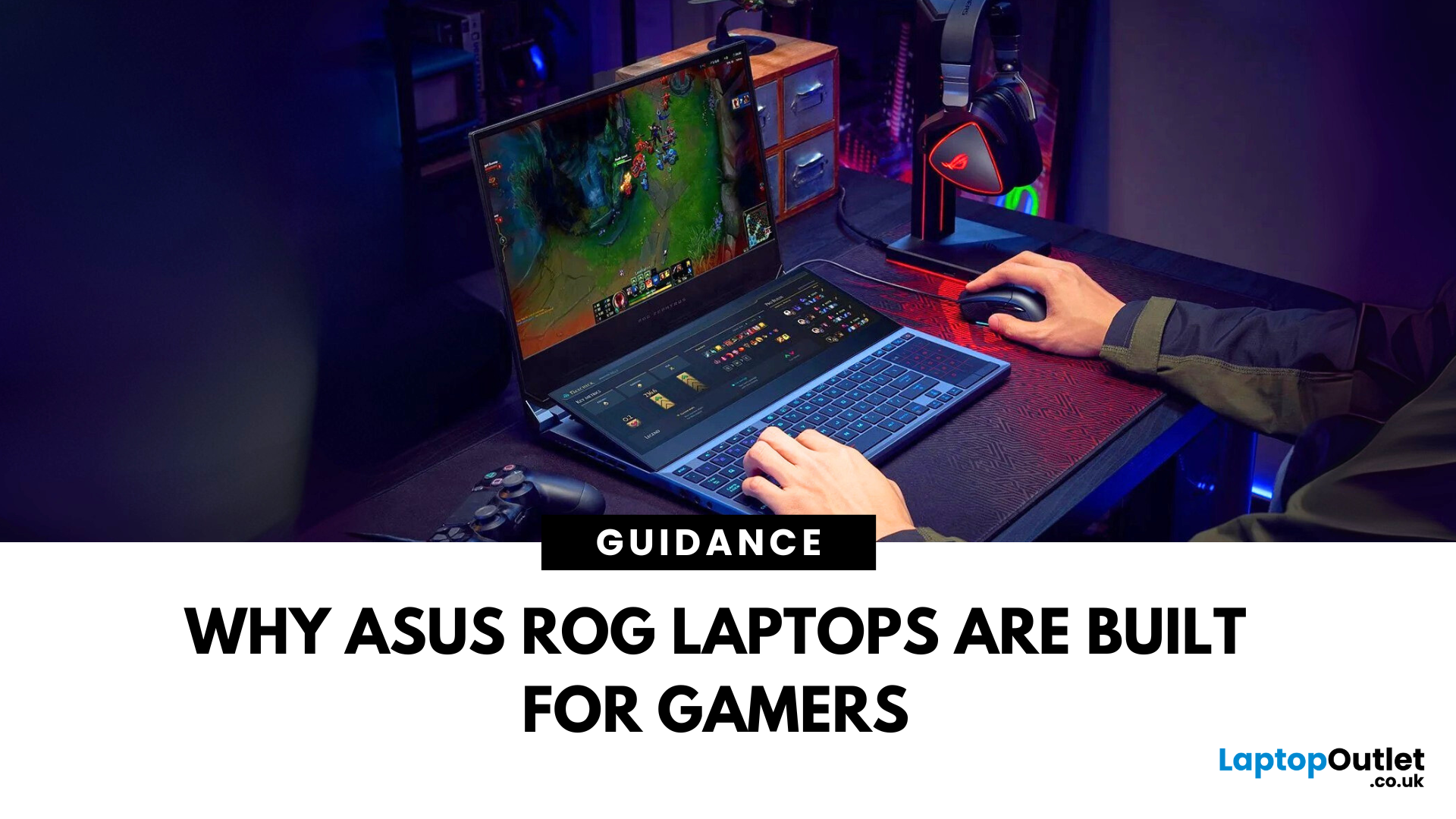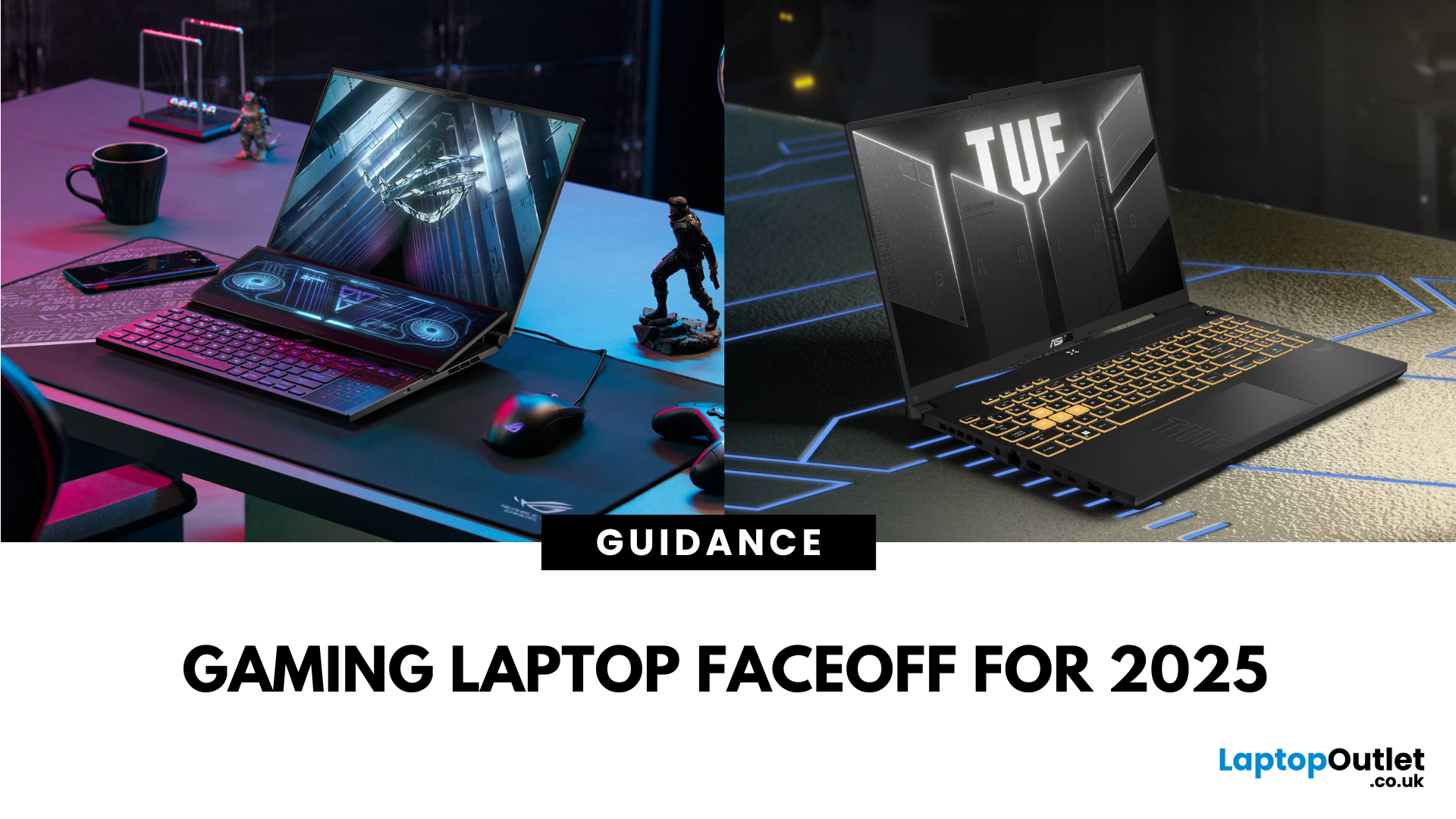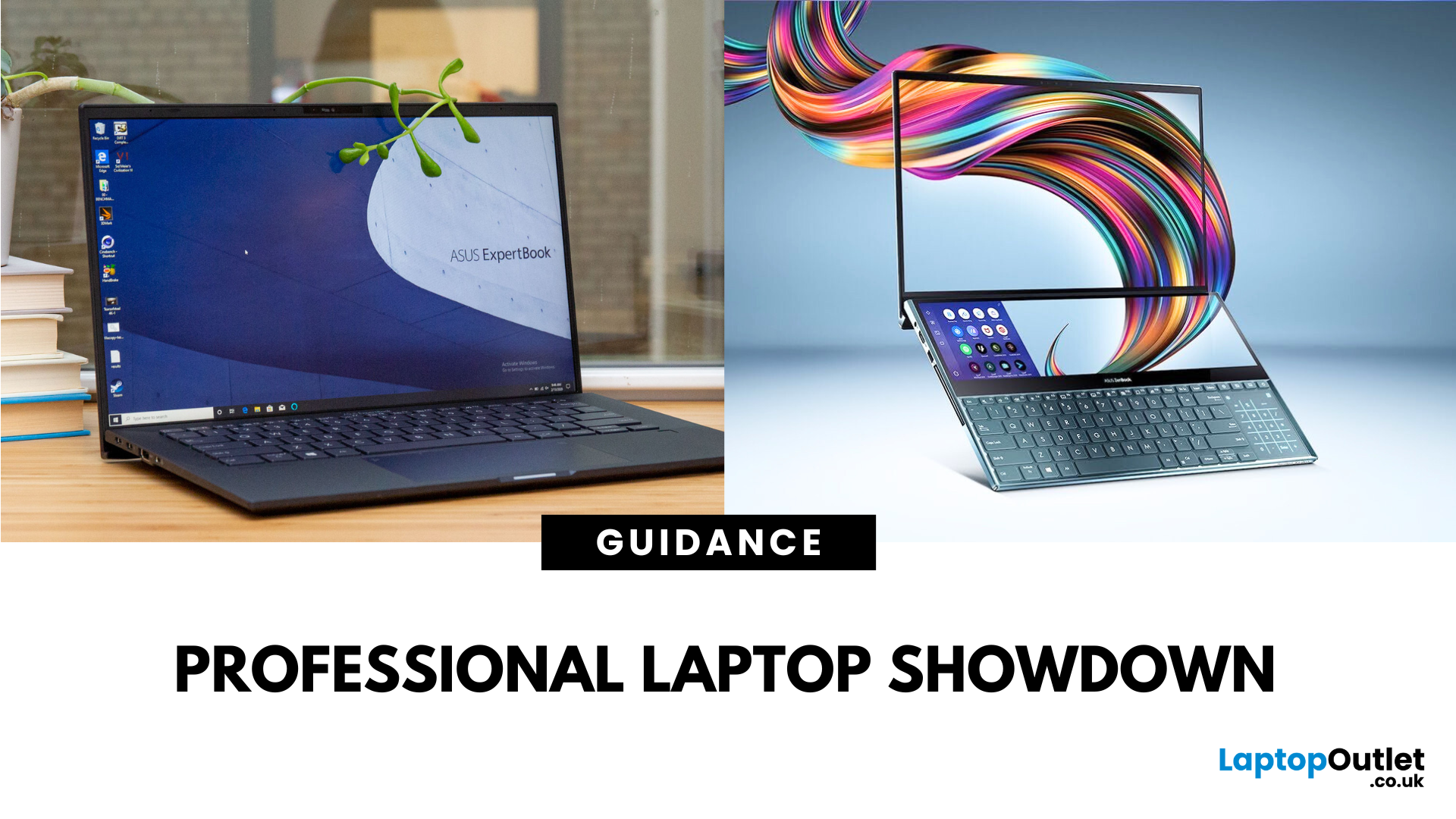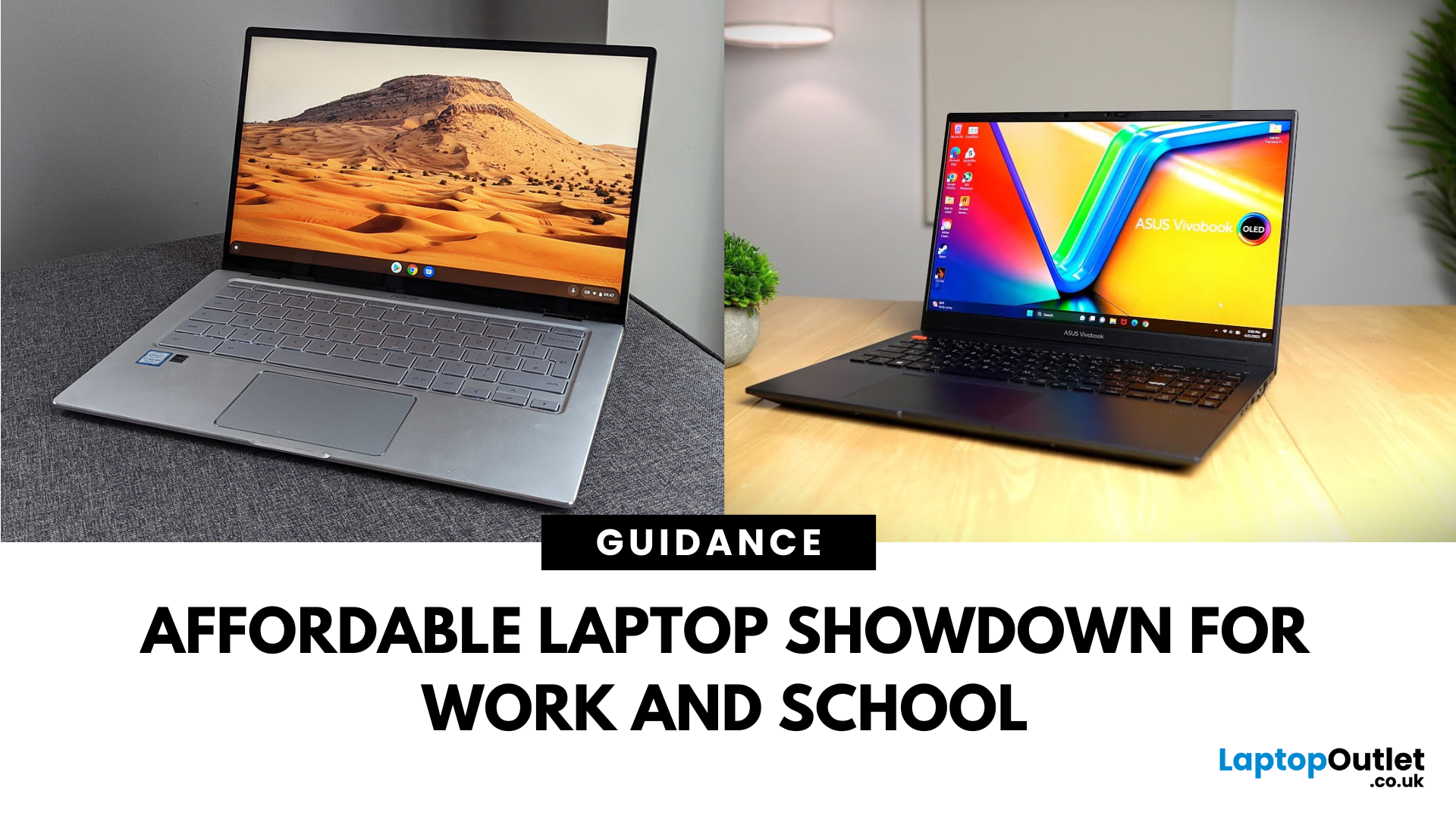ASUS VivoBook vs ZenBook: Which Everyday Laptop Should You Choose?

What’s the Difference Between VivoBook and ZenBook?
VivoBook is ASUS’s mainstream lineup—affordable, performance-balanced laptops for everyday use, students, and casual users. On the other hand, ZenBook is the premium alternative—sleek, aluminum builds, slim profiles, higher specs, and aimed at professionals or users who want long-term durability and style.
Feature Comparison Table
|
Feature |
VivoBook |
ZenBook |
|
Build & Design |
Plastic/metal mix, budget-friendly |
All-metal, ultra-slim premium build |
|
Performance |
Good everyday CPUs (e.g. Ryzen 5, Intel U-series) |
Higher-end CPUs, often Core Ultra or better |
|
Display |
Reliable FHD panels |
Often OLED or higher-quality touchscreens |
|
Battery Life |
Solid, entry-level (~8–10 h) |
Excellent endurance—up to ~16 h on OLED ZenBook 14 OLED |
|
Portability |
Moderate—lighter options available |
Thinner and lighter overall |
|
Price |
Very budget-friendly |
Premium pricing, but great value for specs |
Performance & Design
- VivoBook: Offers solid specs for everyday productivity at an accessible price. Great for students and casual users.
- ZenBook: Benefits from premium aluminum builds, stylish designs, and powerful internal components.
If you need value and reliable performance for everyday tasks, the VivoBook is the better choice for budget-conscious users. However, if you value a sleek, high-quality build with higher specs, the ZenBook could be the right fit for professionals or design-savvy users.
Display & Battery
Life
- VivoBook: Usually comes with FHD panels and solid battery life suitable for daily use.
- ZenBook: Often features OLED displays and can deliver up to around 16 hours on models like the ZenBook 14 OLED.
If you need a crisp display and long battery life for all-day use, the ZenBook is the better choice for frequent travelers or power users. However, if screen quality and extreme battery endurance aren’t top priorities, the VivoBook could be the right fit for everyday use.
Build Quality & Materials
- VivoBook: Typically uses a plastic or hybrid chassis that’s functional and durable but not ultra-premium. Some models include metal top covers for a more refined look.
- ZenBook: Crafted with sleek aluminium unibody designs, the ZenBook feels thinner, sturdier, and more premium overall — it’s also often MIL-STD-810G certified for durability.
If you need a lightweight laptop with a professional, high-end build, the ZenBook is the better choice for premium users. However, if you value a functional and affordable design that gets the job done, the VivoBook could be the right fit for students and casual users.
Port & Connectivity Options
- VivoBook: Offers a good range of essential ports — USB-A, HDMI, headphone jack, and often USB-C. It’s versatile enough for general users.
- ZenBook: Typically includes Thunderbolt 4, high-speed USB-C, and better I/O overall, especially for professionals who need faster data transfer or multiple displays.
If you need advanced ports like Thunderbolt for docking, creative work, or high-speed transfers, the ZenBook is the better choice for professionals. However, if standard connectivity is enough for day-to-day tasks, the VivoBook could be the right fit.
Audio & Webcam Quality
- VivoBook: Offers decent stereo speakers and standard 720p webcams — good enough for Zoom calls and media playback, but nothing fancy.
- ZenBook: Includes enhanced audio tuning (often Harman/Kardon) and upgraded webcams — with some models offering Full HD cameras or AI-enhanced video for sharper conference calls.
If you need crisp visuals and better sound for remote work or content creation, the ZenBook is the better choice for a premium experience. However, if basic audio/video gets the job done, the VivoBook could be the right fit for general use.
ASUS VivoBook vs ZenBook: Pros & Cons
|
Laptop Line |
Pros |
Cons |
|
VivoBook |
Affordable; dependable raw performance; larger screens |
Less premium build; shorter battery life |
|
ZenBook |
Sleek metal design; superior displays; longer battery life |
Higher price point |
Which Should You Choose?
Choose VivoBook if you want solid everyday performance at the best price.
Choose ZenBook if you want premium styling, better displays, and impressive longevity—even if it costs more.
Ready to upgrade? Dive into our ASUS VivoBook collection or step up to a sleek ASUS ZenBook - shop now and find the perfect everyday companion for your lifestyle.
FAQs
Is the ASUS VivoBook good for casual use?
Yes — VivoBooks are built for reliable everyday performance at a friendly price.
Are ZenBooks more durable than VivoBooks?
Yes. ZenBooks feature aluminum builds and high-quality materials that increase durability and premium feel.
Do ZenBooks offer better battery life than VivoBooks?
Generally, yes. ZenBooks with OLED displays can reach up to around 16 hours, while VivoBooks typically offer good but shorter battery life.
Which series is more affordable, VivoBook or ZenBook?
VivoBook is more affordable and offers excellent value for budget-conscious buyers.
Do ZenBooks perform better than VivoBooks?
Yes. ZenBooks often come equipped with higher-end CPUs and better displays, delivering stronger performance overall.
Summary
The ASUS VivoBook is a budget-friendly everyday laptop designed for students and casual users who want dependable performance and larger screens at an accessible price.
The ASUS ZenBook, on the other hand, delivers premium build quality, OLED display options, and longer battery life — ideal for professionals and creative users. Choose VivoBook for solid value and everyday use. Choose ZenBook if you want a sleek, high-performance laptop built to last.
Watch our Video about the ASUS Zenbook
Read More:
ASUS ExpertBook vs ZenBook: Best Laptop for Professionals in 2025
Related Articles

August 05, 2025
Gaming laptops under £1500 have come a long way. No longer clunky, over-priced machines with loud fans and average performance, they blend power with portability, and some of the best options don't even break the £1500 mark. ASUS has made serious waves in this space, particularly with its ROG and TUF Gaming series. Whether you want slick design, powerhouse internals or high-refresh-rate displays, ASUS has something to fit the bill. We've rounded up a few standout models under £1500 that balance performance, price and practicality.
ASUS ROG Strix G16 (SKU: RFB-G614JU-N3146W)
A gaming laptop under £1500 that doesn't just talk. This 16-inch ASUS ROG Strix G16 packs serious muscle thanks to Intel's 13th-generation Core i7-13650HX processor paired with NVIDIA's RTX 4050 GPU. It's built to keep pace with the demands of modern gaming, offering a fluid experience even on newer titles.
What stands out is the 165Hz WUXGA IPS display. The 1920 x 1200 resolution gives you a bit more screen real estate

August 08, 2025
If you're into gaming and need a laptop that can handle any level of action, whether it's competitive matches, open-world adventures, or fast-paced shooters, ASUS ROG laptops have got you covered. These laptops provide everything you desire: fast performance, smooth graphics, and a design that fits seamlessly into a true gaming setup.
From sleek designs like the ASUS ROG Zephyrus to powerful models with future-proof specs, ASUS ROG Laptops for gamers are made to help you win, whether you’re gaming at home or with friends. In this guide, we’ll explore exactly what makes them ideal for gamers like you.
Why ASUS ROG Laptops Are Built for Gamers
1. High-Performance Specs for Smooth Gaming
The main reason gamers choose ASUS ROG laptops is performance. These machines are packed with high-end components like:
- Latest Intel Core i9 or AMD Ryzen 9 processors
- NVIDIA GeForce RTX graphics cards
- Up to 32GB of RAM and ultra-fast SSD storage
This means games load faster, run smoother, and perform without

August 11, 2025
What’s the Difference Between ASUS ROG and TUF?
ASUS ROG (Republic of Gamers) laptops are your high-end, performance-first beasts—slick designs, premium components, and guitars-playing-level specs for serious gamers. ASUS TUF (The Ultimate Force) models serve up reliable gaming performance, but baptised in sturdier builds and easier affordability.
Specs Face-Off: ROG vs TUF (2025 Models)
|
Spec Category |
ROG Strix G16 / Zephyrus Series |
TUF (A14, A16, F16, A18, etc.) |
|
GPUs |
RTX 5070 Ti / RTX 5080 (up to 16 GB GDDR7) |
RTX 5060 / 5070 (up to 8 GB–12 GB) |
|
CPUs |
Ryzen 9 9955HX3D, Core Ultra 9 275HX |
Ryzen AI 9 HX 370, Ryzen 9 270, Core i7 H-series |
|
Displays |
16″ QHD (2560×1600), 240 Hz, 500 nits brightness, 189 ppi |
14–18″ FHD/QHD, 144–165 Hz refresh, around 300–500 nits; 165 Hz QHD on A14 |
|
Build & Weight |
Premium chassis, ~2.7 kg for 16″ models |
Military-grade ruggedness, lighter ~2.0–2.5 kg depending on size |
|
RAM & Storage |
Supports up to 64 GB DDR5, 4 TB SSD, PCIe Gen 4; Thunderbolt 4/USB-4 |
Similar upgrade |

August 13, 2025
What’s the Main Difference Between ASUS ProArt and ZenBook?
The ASUS ProArt series is engineered for professional content creators working in video production, photography, animation, and 3D modelling. It delivers ISV-certified performance, ultra-accurate colour displays, and AI-powered creator tools like ASUS DialPad and Creator Hub.
The ASUS ZenBook series targets professionals and creatives who need portability, battery endurance, and sleek aesthetics. While still capable for creative work, ZenBooks are tuned for light-to-moderate creative tasks, multitasking, and on-the-go use rather than maximum workstation output.
Specs Face-Off: ASUS ProArt vs ZenBook
|
Feature |
ASUS ProArt Series |
ASUS ZenBook Series |
|
Target Audience |
Professional creators needing maximum power and colour precision |
Mobile creatives, designers, and professionals seeking portability and style |
|
Performance Focus |
Workstation CPUs & NVIDIA RTX GPUs, ISV-certified for Adobe/Autodesk |
Efficient CPUs, integrated or mid-tier GPUs, |

August 13, 2025
What’s the Difference Between ExpertBook and ZenBook?
The ExpertBook line is designed for professionals who demand durability, lightweight builds, enterprise features, and long battery life often with vPro support and MIL-STD testing. The ZenBook series decks out innovators and creators with premium OLED (and even dual-screen) displays, ultra-light designs, and high-end performance geared toward aesthetics and mobility.
Specs Face-Off: ExpertBook vs ZenBook
|
Spec Category |
ExpertBook (e.g., B5, B1, P3) |
ZenBook (e.g., 14 OLED, Duo, S16) |
|
Build & Weight |
Ultra-light (~1.27–1.41 kg), MILSTD durability |
Super-slim (~1.2–1.5 kg), aluminium/titanium builds, dual-screen option |
|
Display & Visuals |
Business-friendly 14" FHD or WQXGA screens, optional touch/stylus |
Stunning 14" 2.8K OLED at 120 Hz, vivid dual-screen Duo models, immersive S16 displays |
|
Performance |
Up to Intel Ultra 7 with vPro, optional Arc/RTX GPU in some models |
Core Ultra 7 or Ryzen AI CPUs, upgraded for creatives and heavy multitasking |

August 15, 2025
What’s the Main Difference Between ASUS VivoBook and ASUS Chromebook?
ASUS VivoBook is a budget-friendly Windows laptop packed with higher specs, better performance, and greater storage—great for everyday creativity, schoolwork, and productivity. ASUS Chromebook runs ChromeOS, offering simplicity, quick startup, and seamless Google ecosystem integration—perfect for browsing, media, and lightweight tasks on a budget.
ASUS VivoBook vs Chromebook: Feature Comparison Table
|
Feature |
ASUS VivoBook |
ASUS Chromebook |
|
Operating System |
Windows 11 (full desktop apps) |
ChromeOS (web & Play Store apps) |
|
Processor Options |
Intel Core / AMD Ryzen / Snapdragon X chips |
Intel Celeron / MediaTek |
|
Storage & Memory |
Up to 512 GB SSD, 16 GB RAM |
eMMC 16–128 GB, 4–8 GB RAM |
|
Display Sizes |
14–16″, up to 1920×1200 or OLED (16") |
11–14″ FHD or HD |
|
Weight & Portability |
1.5–1.9 kg (heavier build) |
1.1–1.5 kg (lighter shell) |
|
Battery Life |
~6–14 hours depending on model |
~10–12 hours |
